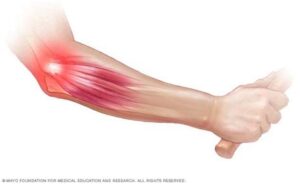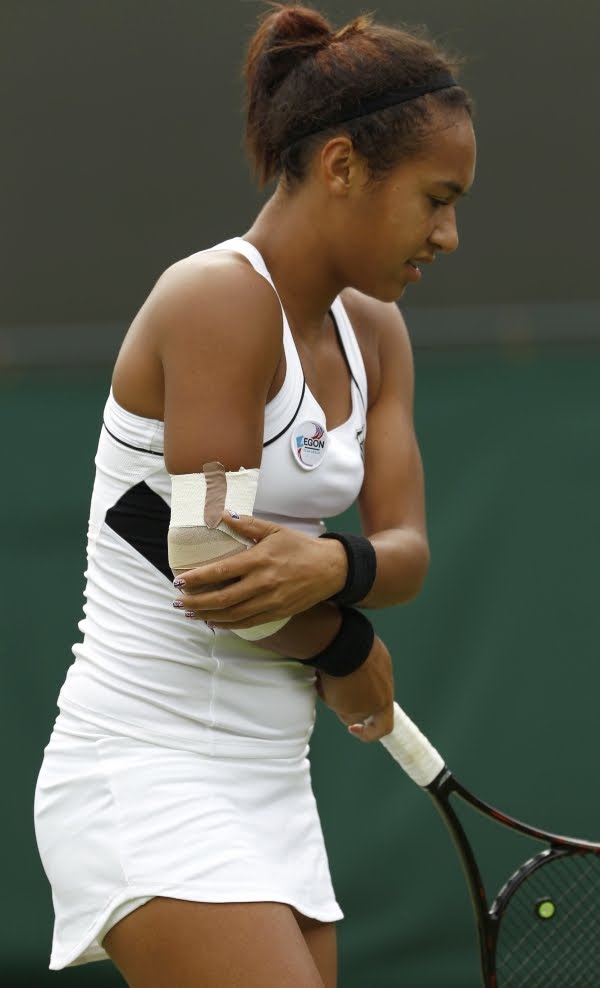 Let’s make sure we’re talking about the same thing here…. Stand relaxed with your arms hanging down and your palms facing forward. Tennis elbow is a burning, deep achy pain affecting the fleshy part on the outside of the elbow. It afflicts many tennis players, although you can get it even if you don’t play tennis.
Let’s make sure we’re talking about the same thing here…. Stand relaxed with your arms hanging down and your palms facing forward. Tennis elbow is a burning, deep achy pain affecting the fleshy part on the outside of the elbow. It afflicts many tennis players, although you can get it even if you don’t play tennis.
Tennis players get it frequently from lots of hard serving (especially when trying to spin the ball) or doing frequent one-handed backhands. But regardless of how you got it, tennis elbow is an overuse injury. If you do some activity that requires frequent wrist extension (the motion your wrist does when you lift your fingers up towards the sky) or wrist pronation (the motion your wrist does when you turn your hand from palm-up to palm-down), then you may get tennis elbow.
 So you think you have it. What should you do? The first thing you should do is to get it correctly diagnosed. Visit one of our doctors at BTF so we can examine your elbow. We will palpate around the area and stretch affected muscles, ask you to resist certain motions, and feel the texture of the involved structures to see if they feel leathery, grainy, or don’t move the way they should. We will even examine your wrist, shoulder and neck to make sure that your elbow pain isn’t being caused by a compensatory type of injury. If we agree that you have tennis elbow we may use the term “lateral epicondylosis” to correctly diagnosis your injury. Tennis elbow is actually just the laypersons term for this type of elbow pain (remember you don’t have to be a tennis player to get this type of injury).
So you think you have it. What should you do? The first thing you should do is to get it correctly diagnosed. Visit one of our doctors at BTF so we can examine your elbow. We will palpate around the area and stretch affected muscles, ask you to resist certain motions, and feel the texture of the involved structures to see if they feel leathery, grainy, or don’t move the way they should. We will even examine your wrist, shoulder and neck to make sure that your elbow pain isn’t being caused by a compensatory type of injury. If we agree that you have tennis elbow we may use the term “lateral epicondylosis” to correctly diagnosis your injury. Tennis elbow is actually just the laypersons term for this type of elbow pain (remember you don’t have to be a tennis player to get this type of injury).
So now you know you have “tennis elbow”. What now? Well, you have options here, which range from getting surgery to doing absolutely nothing.
If you decide to get surgery (this should be the last resort after all else has failed), your surgeon will most likely trim the tendon of the chief muscle involved in this condition: the extensor carpi radialis brevis, or ECRB. Those undergoing ECRB tenotomies or surgical releases experience an average improvement to their pain of 28% (see reference 1 below).
Another option is to have a cortisone injection in the affected part of the elbow. This can significantly decrease your elbow pain but does not address what caused the elbow pain in the first place. If you decide to get an injection, make sure to also visit us at BTF so that we can provide you with exercise strategies to avoid future flare ups of elbow pain.
If you do nothing (like avoid playing tennis), the pain may go away completely on its own! However, the dense scar tissue that usually forms around the elbow with this type of injury, is still there. The muscles and tendons in your arm are still weak and tight. Your arm and hand isn’t as strong as it should be. You aren’t able to function at 100% of where you should be and you’re more susceptible to re-injury.
Another option is to see a sports medicine doctor who specializes in soft tissue treatment. Your BTF doctor can use his/her hands to break up the scar tissue, increase oxygen delivery, lengthen the contracted muscles and tendons, free any entrapped nerves, get the myofascial structures moving the specific ways they should (see reference 2 below), and help you to strengthen them so they stay that way.
If you have an elbow complaint please contact our office at 310-534-1900 to schedule an evaluation with one of our doctors at BTF.
Game, set, match!
References
Buchbinder R, Johnston RV, Barnsley L, Assendelft WJJ, Bell SN, Smidt N. Surgery for lateral elbow pain. Cochrane Database of Systematic Reviews 2011, Issue 3. Art. No.: CD003525. DOI: 10.1002/14651858.CD003525.pub2
Howitt, DC, CSCS, Scott D. “Lateral epicondylosis: a case study of conservative care utilizing ART® and rehabilitation.” The Journal of the Canadian Chiropractic Association 50.3 (2006): 182-189. Web.




Dr Moreau,
Excellent discussion of tennis elbow. Thank you for healing my elbow injury induced by excessive tennis!
R. Hofland, PhD
Glad you are feeling better Dr. Hofland!